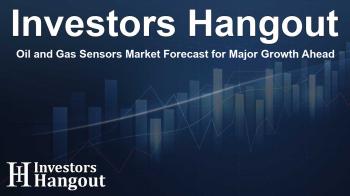Oil and Gas Sensors Market Forecast for Major Growth Ahead

Market Overview of Sensors in Oil and Gas Industry
The global sensors in the oil and gas market is on a robust growth trajectory, expected to witness an increase of USD 1.59 billion from 2025 to 2029. This surge in market size is fueled by the rising liquefied natural gas (LNG) trade and significant advancements in artificial intelligence (AI) technologies. The adoption of AI is transforming operational efficiencies across the oil and gas sectors, ensuring that organizations can navigate the complexities of modern energy demands effectively.
Driving Trends Behind Market Growth
AI is not just a buzzword; it is a driving force behind market evolution. Key factors propelling this market include a global shift towards IoT powered devices and improvements in sensor technologies. The industry is witnessing more robust governmental policies aimed at ensuring productivity and enhancing environmental performance in various operations. This growing focus helps businesses achieve sustainability and carry out their activities with minimal ecological impact.
Technological Innovations in Sensor Applications
Companies are increasingly relying on advanced sensor applications for upstream exploration, refining processes, and downstream operations. These sensors perform critical functions such as measuring flow rates, monitoring pressure, and assessing temperature. The innovations in sensor design enable companies to gain real-time insights into operational performance, leading to better asset management and decision-making.
Challenges Facing the Market
Despite the promising outlook, the market is faced with challenges like the volatility of oil prices, which can significantly impact investment decisions. When oil prices fall, it results in postponement of sensor projects amidst tighter budgets. Conversely, when prices rise, increased pressure to enhance production can overwhelm the sensor supply chain. Companies must develop strategies that mitigate these risks to ensure steady growth within the sector.
Sensor Types and Their Functionality
The market for sensors is primarily segmented into wired and wireless types. Wired sensors are known for their reliability and accuracy, making them indispensable for applications that require constant and precise data exchange. On the other hand, wireless sensors offer flexibility and ease of installation, particularly in remote locations.
Importance of IoT in Sensor Development
The Internet of Things (IoT) is revolutionizing the way sensors operate by allowing for interconnected devices that can provide real-time data and analytics. These sensors are essential in enhancing safety through condition monitoring and predictive maintenance, which helps in minimizing downtime and optimizing operational capabilities.
Regional Market Insights
The sensors in the oil and gas market are witnessing varied responses across regions. Asia-Pacific (APAC) leads the market, with significant contributions from key countries including China and India. This region's growth is driven by expanding exploration activities and an increasing need for effective resource management solutions.
North America and Europe also show promising growth due to their existing infrastructure and technological advancements. Companies within these regions are progressively enhancing sensor technologies to meet stringent environmental regulations and performance standards.
Future Applications and Market Potential
The potential for growth in the sensors market goes beyond conventional applications. There is an increasing focus on incorporating renewable energy technologies and electric vehicle servicing into existing platforms, furthering market expansion. The integration of smart sensors capable of performing complex tasks will ensure that businesses continue to harness valuable data for improved performance, safety, and sustainability.
Frequently Asked Questions
1. What is driving the growth of the oil and gas sensors market?
The growth is primarily driven by the rise of LNG trade, advancements in AI technology, and the increasing adoption of IoT devices in the industry.
2. What are the main types of sensors used in this market?
The primary types include wired and wireless sensors, each offering unique advantages depending on the application requirements.
3. How do fluctuations in oil prices affect the market?
Fluctuations in oil prices can lead to delays in sensor projects, affecting production levels and demand for new technologies.
4. Which regions are seeing the most growth in this market?
The Asia-Pacific region, led by countries like China and India, is experiencing the most significant growth, followed closely by North America and Europe.
5. How is AI impacting the sensor technologies in oil and gas?
AI enhances sensor capabilities by improving data analysis, enabling real-time monitoring, and optimizing operational efficiency through predictive maintenance strategies.
About Investors Hangout
Investors Hangout is a leading online stock forum for financial discussion and learning, offering a wide range of free tools and resources. It draws in traders of all levels, who exchange market knowledge, investigate trading tactics, and keep an eye on industry developments in real time. Featuring financial articles, stock message boards, quotes, charts, company profiles, and live news updates. Through cooperative learning and a wealth of informational resources, it helps users from novices creating their first portfolios to experts honing their techniques. Join Investors Hangout today: https://investorshangout.com/
Disclaimer: The content of this article is solely for general informational purposes only; it does not represent legal, financial, or investment advice. Investors Hangout does not offer financial advice; the author is not a licensed financial advisor. Consult a qualified advisor before making any financial or investment decisions based on this article. The author's interpretation of publicly available data shapes the opinions presented here; as a result, they should not be taken as advice to purchase, sell, or hold any securities mentioned or any other investments. The author does not guarantee the accuracy, completeness, or timeliness of any material, providing it "as is." Information and market conditions may change; past performance is not indicative of future outcomes. If any of the material offered here is inaccurate, please contact us for corrections.
